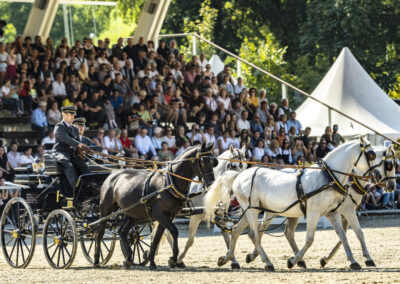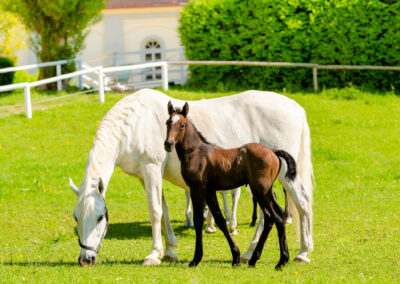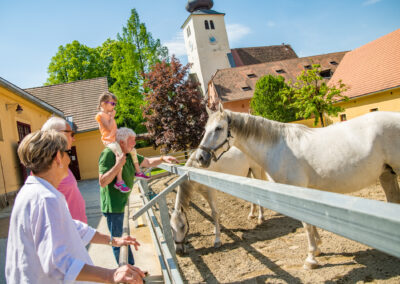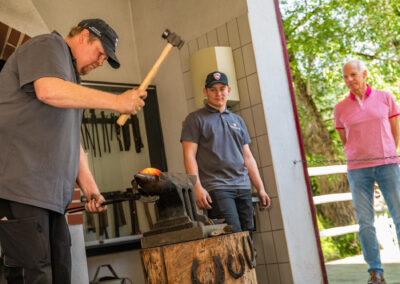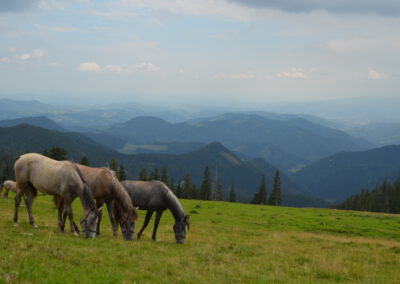Piber Lipizzan Stud
Austria
Piber Lipizzaner Stud Farm – nursery of the world-famous Lipizzaner stallions of the Spanish Riding School
Since 1920, the Piber Lipizzaner Stud Farm in Western Styria has been pursuing the important task of breeding the oldest cultivated horse breed in Europe – the Lipizzaner. In doing so, the stud has safeguarded the international UNESCO intangible cultural heritage of knowledge relating to the breeding and rearing of these horses. Together with the Spanish Riding School in Vienna, the knowledge of the high school of classical horsemanship – also represented on UNESCO’s representative list of intangible cultural heritage – is also passed on and communicated. At the same time, the stud is also responsible for the offspring of the world-famous wise stallions of the Spanish Riding School.
The stud is the home of the wise horses – from their childhood to their retirement. Around 40 to 50 Lipizzaner foals are born here every year. They are offered a varied and educational everyday life until they give birth to further foals as broodmares, are used as representative mares for carriage rides and demonstrations at the stud or move to Heldenberg for training as stallions and finally to Vienna for their performances at the Spanish Riding School. After their active time, both the stallions and the mares retire to their birthplace of Piber.
Piber Lipizzan Stud
Piber 1
8580 Köflach
Austria
www.piber.com
E-Mail: office@piber.com
History of the stud farm
Piber was first mentioned as a stud farm in 1798 – it was initially used to train army horses. Breeding of Lipizzaners began in 1920, when Austria received 97 Lipizzaners after the First World War. These returned to an environment similar to their origins in Lipica (Slovenia). During the Second World War, the horses were moved to Hostau in the Bohemian Forest and only returned to Styria in 1952.
Breeding and rearing the Lipizzaner
Today’s breeding is based on six stallion lines and 17 mare families dating back to the 18th century. The stud library in Piber Castle contains stud books with pedigree records dating back to 1700. Breeding is carried out as pure breeding, with animal welfare having the highest priority. This includes the constant further development of horse husbandry and the animal health manual, the highest hygiene standards, training plans adapted to the horses’ needs and appropriate exercise management, veterinary support, top quality feed, the stud’s own farriery, cooperation with veterinary universities, summer alping of young horses and much more.
Tasks and structure of the stud farm
The Piber Lipizzaner Stud consists of the mother stud in Piber, four outlying farms as well as around 550 hectares of pasture, alpine pasture, arable and stud farm land and 120 hectares of forest. Around 300 Lipizzaners – from the youngest foals to the oldest boarding horses – are permanently kept at the stud itself and on the adjacent outlying farms.
Around 70 employees are responsible for the breeding, rearing and care of the horses as well as the tourism business at the Lipizzaner Stud Piber. In addition to a 24/7 operation in horse care, the administration and tourism office is available daily during opening hours for administrative activities and inquiries from interested parties. The Kampl, Wilhelm and Rheinthalerhof outdoor stables are an important part of the stud farm. The young mares and stallions spend their youth on the Rheinthalerhof and Wilhelm outlying farms and the adjacent mountain pastures. Above all, their stay at around 1,600 meters above sea level on the Stubalm (stallions) and the Brendlalm (mares) makes an important contribution to the development and health of the horses. The annual Lipizzaner cattle drive in September is a particularly popular tradition in the region.
Several hundred hectares of mowing and grazing areas, alpine pastures and forest areas are farmed on the farm. The new hay drying plant built in 2021 ensures the high quality of the horses’ forage. By processing the feed from the field, heating the facility with wood chips from the farm’s own forest and using the horse manure as fertilizer for the green areas and much more, modern agriculture in Piber is a prime example of a successful circular economy.
The Piber Lipizzaner stud farm as a tourist business
Thanks to extensive renovations and modern infrastructure, Piber is now an attractive destination for excursions. Visitors can get closer to the horses and learn more about their life at the stud. Piber offers a varied adventure program and instructive insights into the breeding and rearing of Lipizzaners.
With its stables, paddocks, baroque castle, interactive museum and historic carriages, as well as a café-restaurant and an event arena, the stud farm offers a wide range of Lipizzaner-related experiences. The Lipizzaners can be experienced, for example, as part of guided tours of the stud farm, carriage rides or demonstrations at the annual “Festival of the Lipizzaners” in the fall. The first spring gala in May 2024, at which the activities and tasks of the stud farm could be experienced as part of adventure stations, was very popular.
Piber Castle with its state rooms, the coach house with its historic carriages and the spacious grounds are also popular for weddings, birthdays, family celebrations and seminars.
